HND701 - Pathophysiology of Diabetes: Complications Report
VerifiedAdded on 2022/11/17
|16
|4346
|158
Report
AI Summary
This report, prepared for the HND701 Pathophysiology of Diabetes course, comprehensively examines the microvascular and macrovascular complications associated with diabetes. It is divided into three parts, each focusing on a specific complication. Part 1 delves into "Metabolic Memory," exploring its impact on vascular stress and the benefits of early intensive glucose management, referencing current research literature. Part 2 investigates atherosclerosis, a macrovascular complication, detailing the process, risk factors, and clinical manifestations. Part 3 addresses diabetic nephropathy, outlining its pathophysiology, risk factors, signs, symptoms, and progression. The report emphasizes the importance of early aggressive treatment and prevention strategies to mitigate the long-term effects of diabetes on various organ systems. The student has used a range of sources to support their arguments.
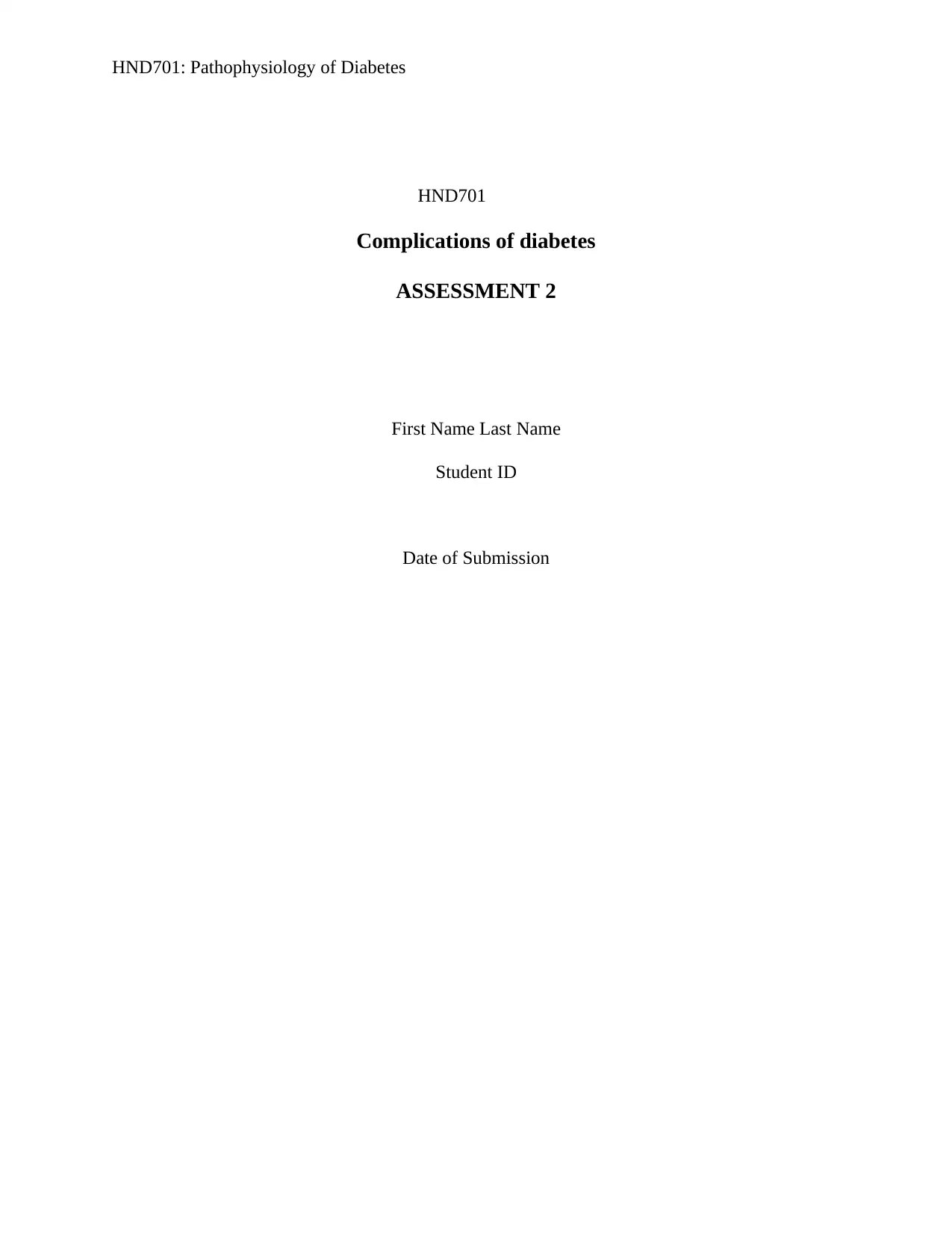
HND701: Pathophysiology of Diabetes
HND701
Complications of diabetes
ASSESSMENT 2
First Name Last Name
Student ID
Date of Submission
HND701
Complications of diabetes
ASSESSMENT 2
First Name Last Name
Student ID
Date of Submission
Paraphrase This Document
Need a fresh take? Get an instant paraphrase of this document with our AI Paraphraser
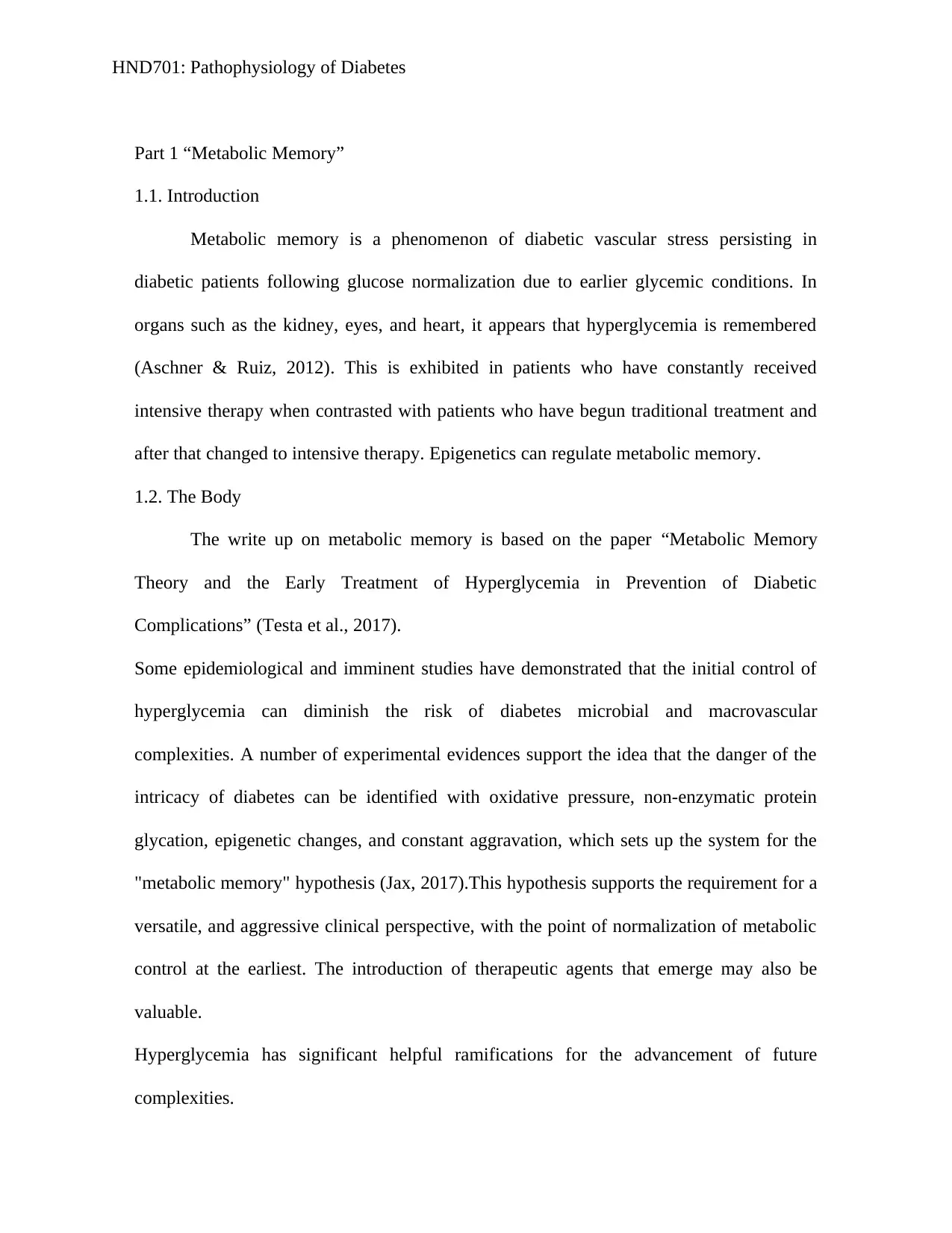
HND701: Pathophysiology of Diabetes
Part 1 “Metabolic Memory”
1.1. Introduction
Metabolic memory is a phenomenon of diabetic vascular stress persisting in
diabetic patients following glucose normalization due to earlier glycemic conditions. In
organs such as the kidney, eyes, and heart, it appears that hyperglycemia is remembered
(Aschner & Ruiz, 2012). This is exhibited in patients who have constantly received
intensive therapy when contrasted with patients who have begun traditional treatment and
after that changed to intensive therapy. Epigenetics can regulate metabolic memory.
1.2. The Body
The write up on metabolic memory is based on the paper “Metabolic Memory
Theory and the Early Treatment of Hyperglycemia in Prevention of Diabetic
Complications” (Testa et al., 2017).
Some epidemiological and imminent studies have demonstrated that the initial control of
hyperglycemia can diminish the risk of diabetes microbial and macrovascular
complexities. A number of experimental evidences support the idea that the danger of the
intricacy of diabetes can be identified with oxidative pressure, non-enzymatic protein
glycation, epigenetic changes, and constant aggravation, which sets up the system for the
"metabolic memory" hypothesis (Jax, 2017).This hypothesis supports the requirement for a
versatile, and aggressive clinical perspective, with the point of normalization of metabolic
control at the earliest. The introduction of therapeutic agents that emerge may also be
valuable.
Hyperglycemia has significant helpful ramifications for the advancement of future
complexities.
Part 1 “Metabolic Memory”
1.1. Introduction
Metabolic memory is a phenomenon of diabetic vascular stress persisting in
diabetic patients following glucose normalization due to earlier glycemic conditions. In
organs such as the kidney, eyes, and heart, it appears that hyperglycemia is remembered
(Aschner & Ruiz, 2012). This is exhibited in patients who have constantly received
intensive therapy when contrasted with patients who have begun traditional treatment and
after that changed to intensive therapy. Epigenetics can regulate metabolic memory.
1.2. The Body
The write up on metabolic memory is based on the paper “Metabolic Memory
Theory and the Early Treatment of Hyperglycemia in Prevention of Diabetic
Complications” (Testa et al., 2017).
Some epidemiological and imminent studies have demonstrated that the initial control of
hyperglycemia can diminish the risk of diabetes microbial and macrovascular
complexities. A number of experimental evidences support the idea that the danger of the
intricacy of diabetes can be identified with oxidative pressure, non-enzymatic protein
glycation, epigenetic changes, and constant aggravation, which sets up the system for the
"metabolic memory" hypothesis (Jax, 2017).This hypothesis supports the requirement for a
versatile, and aggressive clinical perspective, with the point of normalization of metabolic
control at the earliest. The introduction of therapeutic agents that emerge may also be
valuable.
Hyperglycemia has significant helpful ramifications for the advancement of future
complexities.
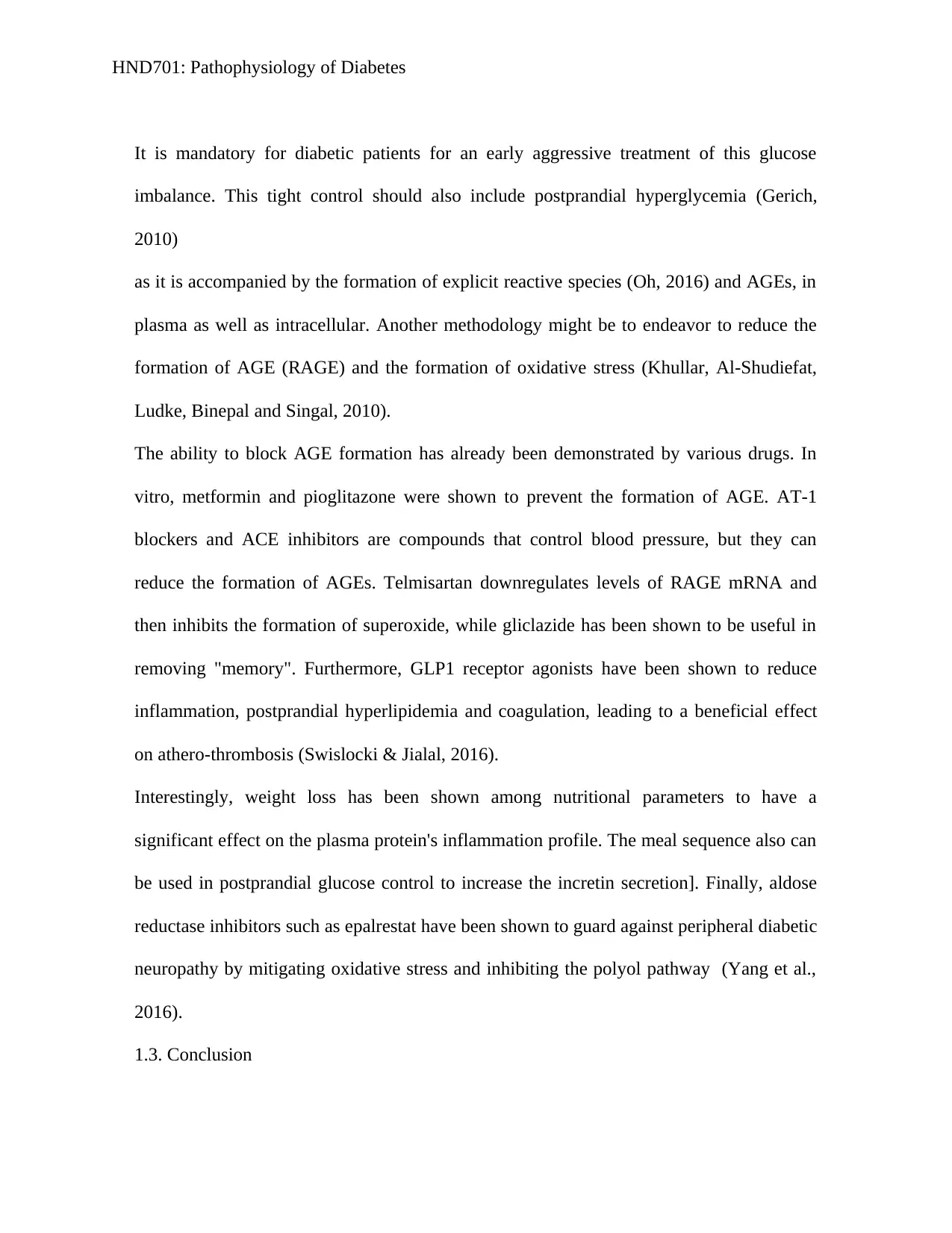
HND701: Pathophysiology of Diabetes
It is mandatory for diabetic patients for an early aggressive treatment of this glucose
imbalance. This tight control should also include postprandial hyperglycemia (Gerich,
2010)
as it is accompanied by the formation of explicit reactive species (Oh, 2016) and AGEs, in
plasma as well as intracellular. Another methodology might be to endeavor to reduce the
formation of AGE (RAGE) and the formation of oxidative stress (Khullar, Al-Shudiefat,
Ludke, Binepal and Singal, 2010).
The ability to block AGE formation has already been demonstrated by various drugs. In
vitro, metformin and pioglitazone were shown to prevent the formation of AGE. AT-1
blockers and ACE inhibitors are compounds that control blood pressure, but they can
reduce the formation of AGEs. Telmisartan downregulates levels of RAGE mRNA and
then inhibits the formation of superoxide, while gliclazide has been shown to be useful in
removing "memory". Furthermore, GLP1 receptor agonists have been shown to reduce
inflammation, postprandial hyperlipidemia and coagulation, leading to a beneficial effect
on athero-thrombosis (Swislocki & Jialal, 2016).
Interestingly, weight loss has been shown among nutritional parameters to have a
significant effect on the plasma protein's inflammation profile. The meal sequence also can
be used in postprandial glucose control to increase the incretin secretion]. Finally, aldose
reductase inhibitors such as epalrestat have been shown to guard against peripheral diabetic
neuropathy by mitigating oxidative stress and inhibiting the polyol pathway (Yang et al.,
2016).
1.3. Conclusion
It is mandatory for diabetic patients for an early aggressive treatment of this glucose
imbalance. This tight control should also include postprandial hyperglycemia (Gerich,
2010)
as it is accompanied by the formation of explicit reactive species (Oh, 2016) and AGEs, in
plasma as well as intracellular. Another methodology might be to endeavor to reduce the
formation of AGE (RAGE) and the formation of oxidative stress (Khullar, Al-Shudiefat,
Ludke, Binepal and Singal, 2010).
The ability to block AGE formation has already been demonstrated by various drugs. In
vitro, metformin and pioglitazone were shown to prevent the formation of AGE. AT-1
blockers and ACE inhibitors are compounds that control blood pressure, but they can
reduce the formation of AGEs. Telmisartan downregulates levels of RAGE mRNA and
then inhibits the formation of superoxide, while gliclazide has been shown to be useful in
removing "memory". Furthermore, GLP1 receptor agonists have been shown to reduce
inflammation, postprandial hyperlipidemia and coagulation, leading to a beneficial effect
on athero-thrombosis (Swislocki & Jialal, 2016).
Interestingly, weight loss has been shown among nutritional parameters to have a
significant effect on the plasma protein's inflammation profile. The meal sequence also can
be used in postprandial glucose control to increase the incretin secretion]. Finally, aldose
reductase inhibitors such as epalrestat have been shown to guard against peripheral diabetic
neuropathy by mitigating oxidative stress and inhibiting the polyol pathway (Yang et al.,
2016).
1.3. Conclusion
⊘ This is a preview!⊘
Do you want full access?
Subscribe today to unlock all pages.

Trusted by 1+ million students worldwide
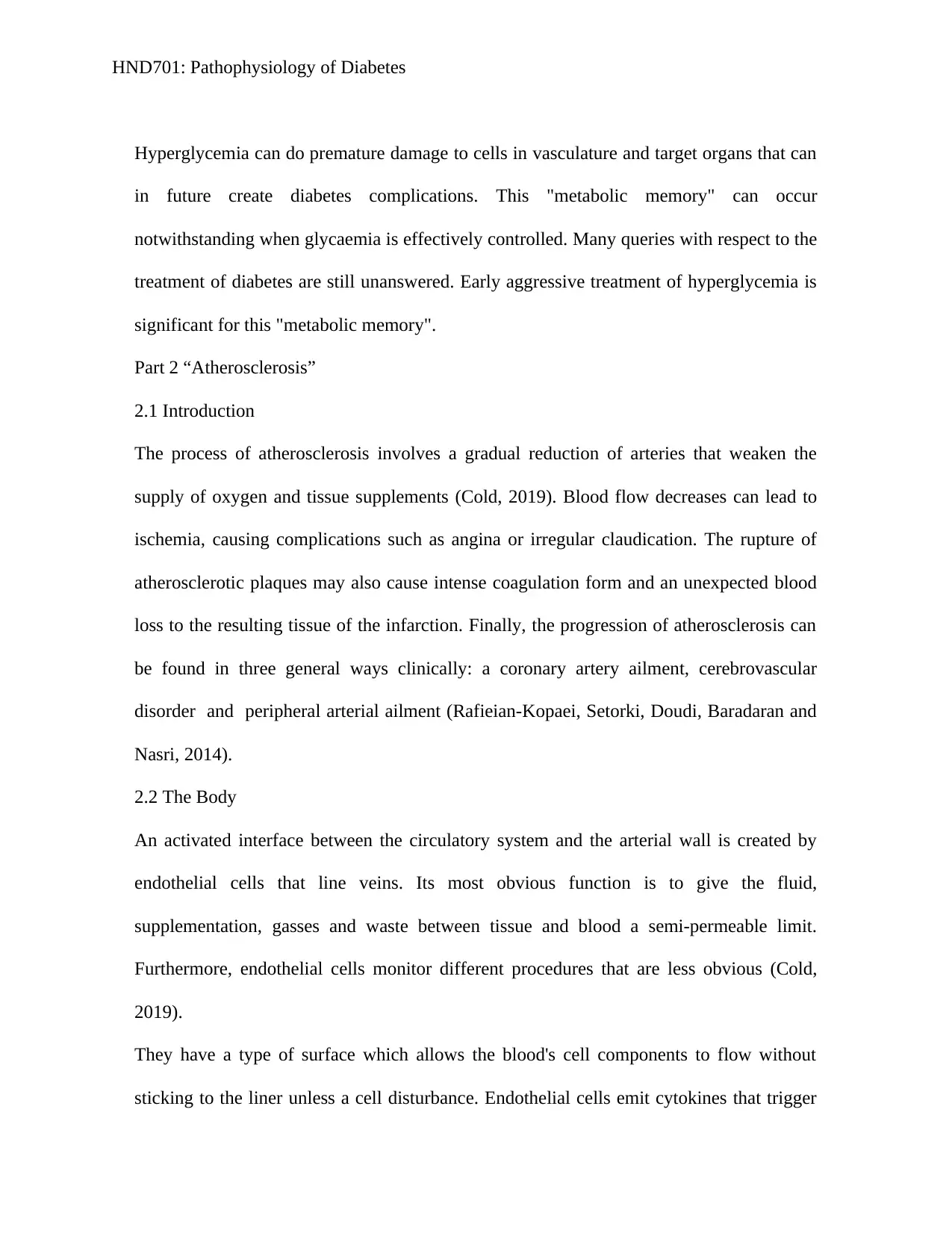
HND701: Pathophysiology of Diabetes
Hyperglycemia can do premature damage to cells in vasculature and target organs that can
in future create diabetes complications. This "metabolic memory" can occur
notwithstanding when glycaemia is effectively controlled. Many queries with respect to the
treatment of diabetes are still unanswered. Early aggressive treatment of hyperglycemia is
significant for this "metabolic memory".
Part 2 “Atherosclerosis”
2.1 Introduction
The process of atherosclerosis involves a gradual reduction of arteries that weaken the
supply of oxygen and tissue supplements (Cold, 2019). Blood flow decreases can lead to
ischemia, causing complications such as angina or irregular claudication. The rupture of
atherosclerotic plaques may also cause intense coagulation form and an unexpected blood
loss to the resulting tissue of the infarction. Finally, the progression of atherosclerosis can
be found in three general ways clinically: a coronary artery ailment, cerebrovascular
disorder and peripheral arterial ailment (Rafieian-Kopaei, Setorki, Doudi, Baradaran and
Nasri, 2014).
2.2 The Body
An activated interface between the circulatory system and the arterial wall is created by
endothelial cells that line veins. Its most obvious function is to give the fluid,
supplementation, gasses and waste between tissue and blood a semi-permeable limit.
Furthermore, endothelial cells monitor different procedures that are less obvious (Cold,
2019).
They have a type of surface which allows the blood's cell components to flow without
sticking to the liner unless a cell disturbance. Endothelial cells emit cytokines that trigger
Hyperglycemia can do premature damage to cells in vasculature and target organs that can
in future create diabetes complications. This "metabolic memory" can occur
notwithstanding when glycaemia is effectively controlled. Many queries with respect to the
treatment of diabetes are still unanswered. Early aggressive treatment of hyperglycemia is
significant for this "metabolic memory".
Part 2 “Atherosclerosis”
2.1 Introduction
The process of atherosclerosis involves a gradual reduction of arteries that weaken the
supply of oxygen and tissue supplements (Cold, 2019). Blood flow decreases can lead to
ischemia, causing complications such as angina or irregular claudication. The rupture of
atherosclerotic plaques may also cause intense coagulation form and an unexpected blood
loss to the resulting tissue of the infarction. Finally, the progression of atherosclerosis can
be found in three general ways clinically: a coronary artery ailment, cerebrovascular
disorder and peripheral arterial ailment (Rafieian-Kopaei, Setorki, Doudi, Baradaran and
Nasri, 2014).
2.2 The Body
An activated interface between the circulatory system and the arterial wall is created by
endothelial cells that line veins. Its most obvious function is to give the fluid,
supplementation, gasses and waste between tissue and blood a semi-permeable limit.
Furthermore, endothelial cells monitor different procedures that are less obvious (Cold,
2019).
They have a type of surface which allows the blood's cell components to flow without
sticking to the liner unless a cell disturbance. Endothelial cells emit cytokines that trigger
Paraphrase This Document
Need a fresh take? Get an instant paraphrase of this document with our AI Paraphraser
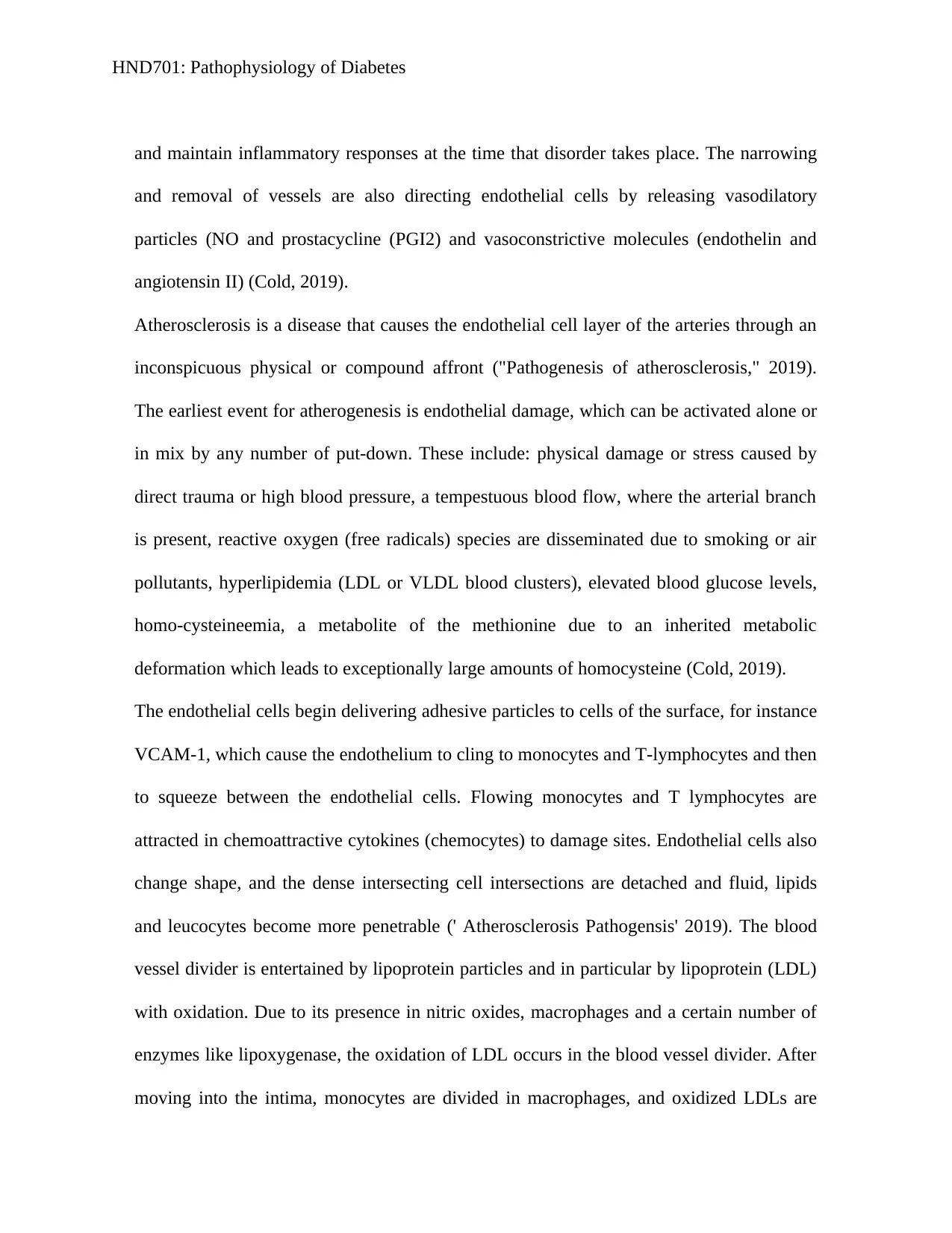
HND701: Pathophysiology of Diabetes
and maintain inflammatory responses at the time that disorder takes place. The narrowing
and removal of vessels are also directing endothelial cells by releasing vasodilatory
particles (NO and prostacycline (PGI2) and vasoconstrictive molecules (endothelin and
angiotensin II) (Cold, 2019).
Atherosclerosis is a disease that causes the endothelial cell layer of the arteries through an
inconspicuous physical or compound affront ("Pathogenesis of atherosclerosis," 2019).
The earliest event for atherogenesis is endothelial damage, which can be activated alone or
in mix by any number of put-down. These include: physical damage or stress caused by
direct trauma or high blood pressure, a tempestuous blood flow, where the arterial branch
is present, reactive oxygen (free radicals) species are disseminated due to smoking or air
pollutants, hyperlipidemia (LDL or VLDL blood clusters), elevated blood glucose levels,
homo-cysteineemia, a metabolite of the methionine due to an inherited metabolic
deformation which leads to exceptionally large amounts of homocysteine (Cold, 2019).
The endothelial cells begin delivering adhesive particles to cells of the surface, for instance
VCAM-1, which cause the endothelium to cling to monocytes and T-lymphocytes and then
to squeeze between the endothelial cells. Flowing monocytes and T lymphocytes are
attracted in chemoattractive cytokines (chemocytes) to damage sites. Endothelial cells also
change shape, and the dense intersecting cell intersections are detached and fluid, lipids
and leucocytes become more penetrable (' Atherosclerosis Pathogensis' 2019). The blood
vessel divider is entertained by lipoprotein particles and in particular by lipoprotein (LDL)
with oxidation. Due to its presence in nitric oxides, macrophages and a certain number of
enzymes like lipoxygenase, the oxidation of LDL occurs in the blood vessel divider. After
moving into the intima, monocytes are divided in macrophages, and oxidized LDLs are
and maintain inflammatory responses at the time that disorder takes place. The narrowing
and removal of vessels are also directing endothelial cells by releasing vasodilatory
particles (NO and prostacycline (PGI2) and vasoconstrictive molecules (endothelin and
angiotensin II) (Cold, 2019).
Atherosclerosis is a disease that causes the endothelial cell layer of the arteries through an
inconspicuous physical or compound affront ("Pathogenesis of atherosclerosis," 2019).
The earliest event for atherogenesis is endothelial damage, which can be activated alone or
in mix by any number of put-down. These include: physical damage or stress caused by
direct trauma or high blood pressure, a tempestuous blood flow, where the arterial branch
is present, reactive oxygen (free radicals) species are disseminated due to smoking or air
pollutants, hyperlipidemia (LDL or VLDL blood clusters), elevated blood glucose levels,
homo-cysteineemia, a metabolite of the methionine due to an inherited metabolic
deformation which leads to exceptionally large amounts of homocysteine (Cold, 2019).
The endothelial cells begin delivering adhesive particles to cells of the surface, for instance
VCAM-1, which cause the endothelium to cling to monocytes and T-lymphocytes and then
to squeeze between the endothelial cells. Flowing monocytes and T lymphocytes are
attracted in chemoattractive cytokines (chemocytes) to damage sites. Endothelial cells also
change shape, and the dense intersecting cell intersections are detached and fluid, lipids
and leucocytes become more penetrable (' Atherosclerosis Pathogensis' 2019). The blood
vessel divider is entertained by lipoprotein particles and in particular by lipoprotein (LDL)
with oxidation. Due to its presence in nitric oxides, macrophages and a certain number of
enzymes like lipoxygenase, the oxidation of LDL occurs in the blood vessel divider. After
moving into the intima, monocytes are divided in macrophages, and oxidized LDLs are
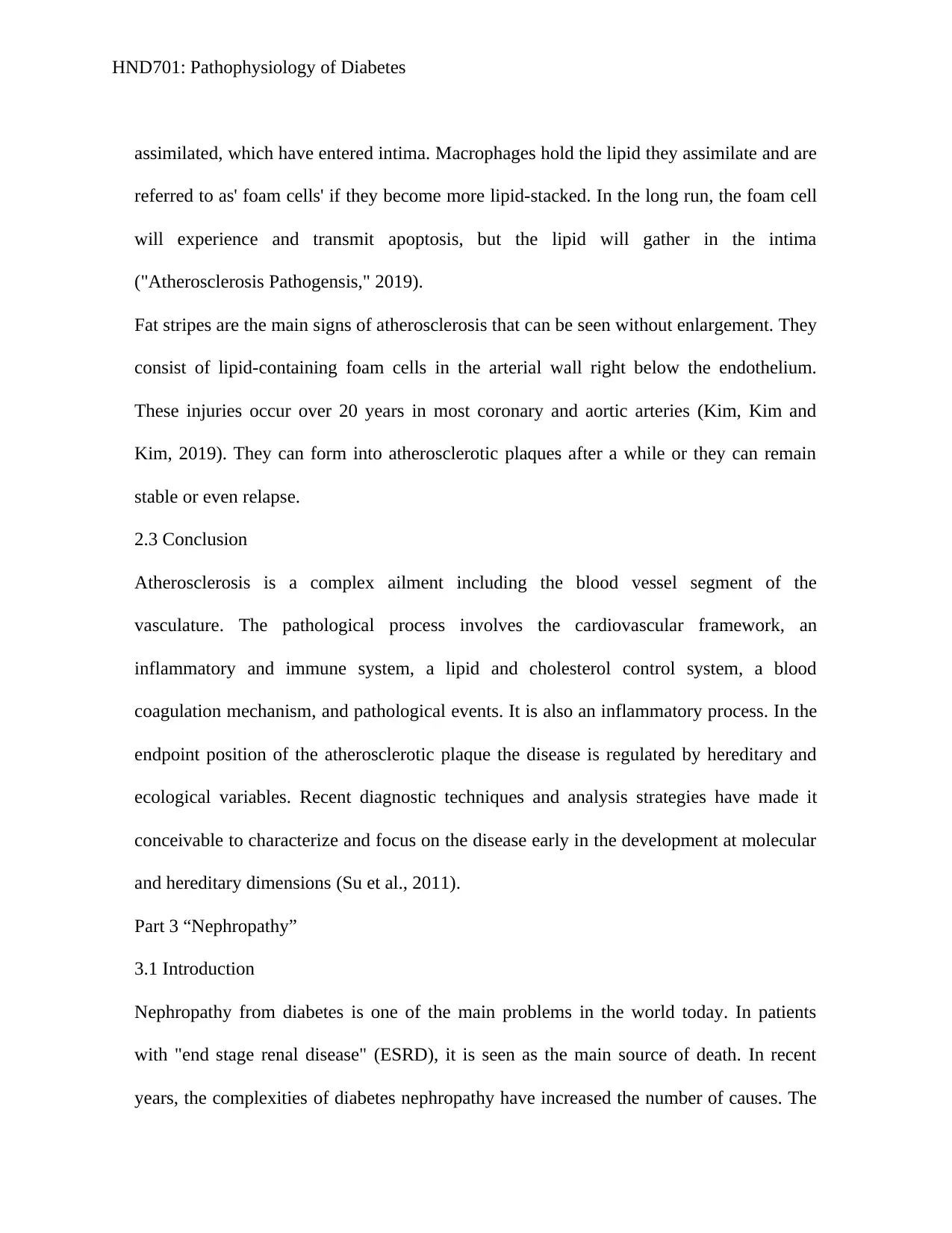
HND701: Pathophysiology of Diabetes
assimilated, which have entered intima. Macrophages hold the lipid they assimilate and are
referred to as' foam cells' if they become more lipid-stacked. In the long run, the foam cell
will experience and transmit apoptosis, but the lipid will gather in the intima
("Atherosclerosis Pathogensis," 2019).
Fat stripes are the main signs of atherosclerosis that can be seen without enlargement. They
consist of lipid-containing foam cells in the arterial wall right below the endothelium.
These injuries occur over 20 years in most coronary and aortic arteries (Kim, Kim and
Kim, 2019). They can form into atherosclerotic plaques after a while or they can remain
stable or even relapse.
2.3 Conclusion
Atherosclerosis is a complex ailment including the blood vessel segment of the
vasculature. The pathological process involves the cardiovascular framework, an
inflammatory and immune system, a lipid and cholesterol control system, a blood
coagulation mechanism, and pathological events. It is also an inflammatory process. In the
endpoint position of the atherosclerotic plaque the disease is regulated by hereditary and
ecological variables. Recent diagnostic techniques and analysis strategies have made it
conceivable to characterize and focus on the disease early in the development at molecular
and hereditary dimensions (Su et al., 2011).
Part 3 “Nephropathy”
3.1 Introduction
Nephropathy from diabetes is one of the main problems in the world today. In patients
with "end stage renal disease" (ESRD), it is seen as the main source of death. In recent
years, the complexities of diabetes nephropathy have increased the number of causes. The
assimilated, which have entered intima. Macrophages hold the lipid they assimilate and are
referred to as' foam cells' if they become more lipid-stacked. In the long run, the foam cell
will experience and transmit apoptosis, but the lipid will gather in the intima
("Atherosclerosis Pathogensis," 2019).
Fat stripes are the main signs of atherosclerosis that can be seen without enlargement. They
consist of lipid-containing foam cells in the arterial wall right below the endothelium.
These injuries occur over 20 years in most coronary and aortic arteries (Kim, Kim and
Kim, 2019). They can form into atherosclerotic plaques after a while or they can remain
stable or even relapse.
2.3 Conclusion
Atherosclerosis is a complex ailment including the blood vessel segment of the
vasculature. The pathological process involves the cardiovascular framework, an
inflammatory and immune system, a lipid and cholesterol control system, a blood
coagulation mechanism, and pathological events. It is also an inflammatory process. In the
endpoint position of the atherosclerotic plaque the disease is regulated by hereditary and
ecological variables. Recent diagnostic techniques and analysis strategies have made it
conceivable to characterize and focus on the disease early in the development at molecular
and hereditary dimensions (Su et al., 2011).
Part 3 “Nephropathy”
3.1 Introduction
Nephropathy from diabetes is one of the main problems in the world today. In patients
with "end stage renal disease" (ESRD), it is seen as the main source of death. In recent
years, the complexities of diabetes nephropathy have increased the number of causes. The
⊘ This is a preview!⊘
Do you want full access?
Subscribe today to unlock all pages.

Trusted by 1+ million students worldwide
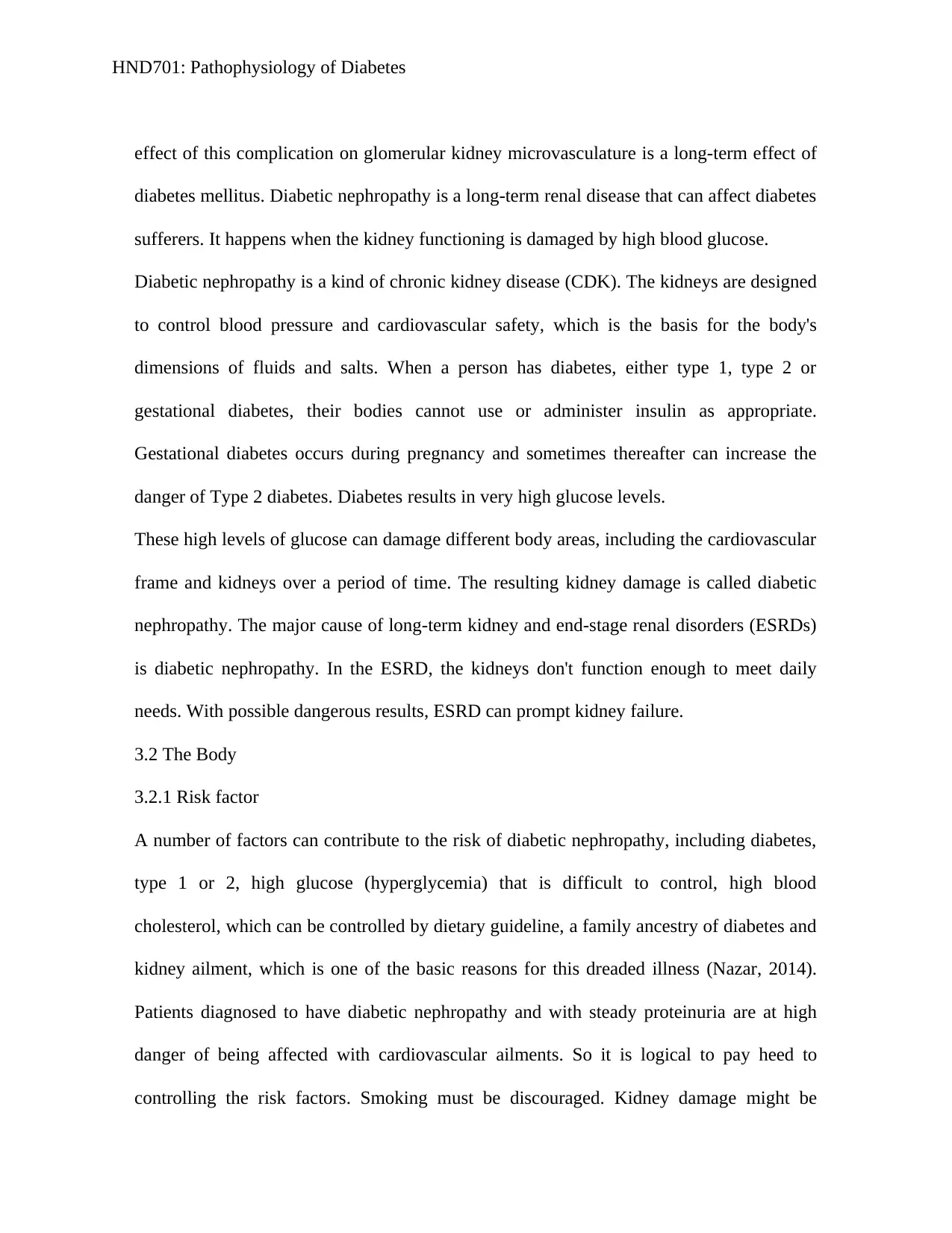
HND701: Pathophysiology of Diabetes
effect of this complication on glomerular kidney microvasculature is a long-term effect of
diabetes mellitus. Diabetic nephropathy is a long-term renal disease that can affect diabetes
sufferers. It happens when the kidney functioning is damaged by high blood glucose.
Diabetic nephropathy is a kind of chronic kidney disease (CDK). The kidneys are designed
to control blood pressure and cardiovascular safety, which is the basis for the body's
dimensions of fluids and salts. When a person has diabetes, either type 1, type 2 or
gestational diabetes, their bodies cannot use or administer insulin as appropriate.
Gestational diabetes occurs during pregnancy and sometimes thereafter can increase the
danger of Type 2 diabetes. Diabetes results in very high glucose levels.
These high levels of glucose can damage different body areas, including the cardiovascular
frame and kidneys over a period of time. The resulting kidney damage is called diabetic
nephropathy. The major cause of long-term kidney and end-stage renal disorders (ESRDs)
is diabetic nephropathy. In the ESRD, the kidneys don't function enough to meet daily
needs. With possible dangerous results, ESRD can prompt kidney failure.
3.2 The Body
3.2.1 Risk factor
A number of factors can contribute to the risk of diabetic nephropathy, including diabetes,
type 1 or 2, high glucose (hyperglycemia) that is difficult to control, high blood
cholesterol, which can be controlled by dietary guideline, a family ancestry of diabetes and
kidney ailment, which is one of the basic reasons for this dreaded illness (Nazar, 2014).
Patients diagnosed to have diabetic nephropathy and with steady proteinuria are at high
danger of being affected with cardiovascular ailments. So it is logical to pay heed to
controlling the risk factors. Smoking must be discouraged. Kidney damage might be
effect of this complication on glomerular kidney microvasculature is a long-term effect of
diabetes mellitus. Diabetic nephropathy is a long-term renal disease that can affect diabetes
sufferers. It happens when the kidney functioning is damaged by high blood glucose.
Diabetic nephropathy is a kind of chronic kidney disease (CDK). The kidneys are designed
to control blood pressure and cardiovascular safety, which is the basis for the body's
dimensions of fluids and salts. When a person has diabetes, either type 1, type 2 or
gestational diabetes, their bodies cannot use or administer insulin as appropriate.
Gestational diabetes occurs during pregnancy and sometimes thereafter can increase the
danger of Type 2 diabetes. Diabetes results in very high glucose levels.
These high levels of glucose can damage different body areas, including the cardiovascular
frame and kidneys over a period of time. The resulting kidney damage is called diabetic
nephropathy. The major cause of long-term kidney and end-stage renal disorders (ESRDs)
is diabetic nephropathy. In the ESRD, the kidneys don't function enough to meet daily
needs. With possible dangerous results, ESRD can prompt kidney failure.
3.2 The Body
3.2.1 Risk factor
A number of factors can contribute to the risk of diabetic nephropathy, including diabetes,
type 1 or 2, high glucose (hyperglycemia) that is difficult to control, high blood
cholesterol, which can be controlled by dietary guideline, a family ancestry of diabetes and
kidney ailment, which is one of the basic reasons for this dreaded illness (Nazar, 2014).
Patients diagnosed to have diabetic nephropathy and with steady proteinuria are at high
danger of being affected with cardiovascular ailments. So it is logical to pay heed to
controlling the risk factors. Smoking must be discouraged. Kidney damage might be
Paraphrase This Document
Need a fresh take? Get an instant paraphrase of this document with our AI Paraphraser
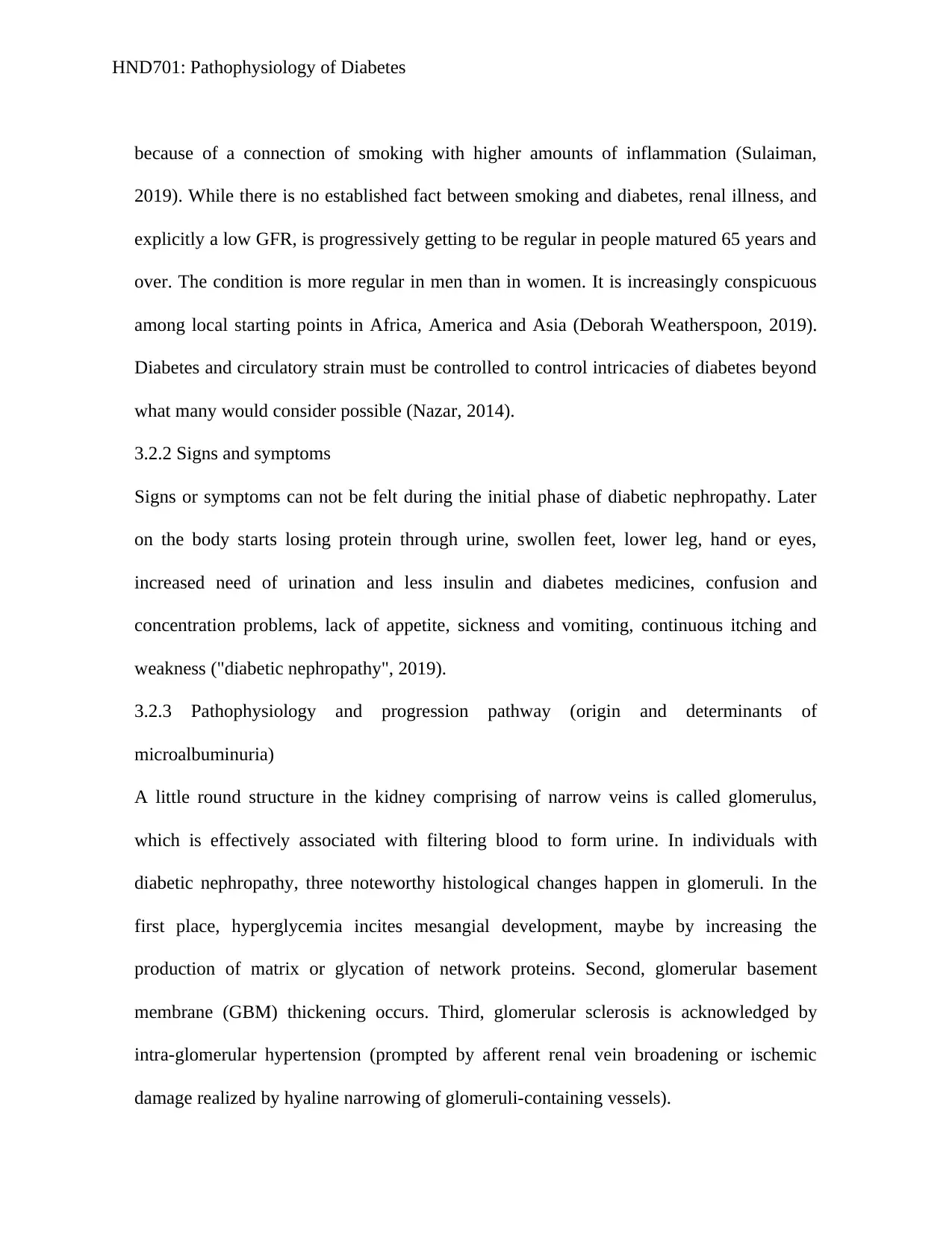
HND701: Pathophysiology of Diabetes
because of a connection of smoking with higher amounts of inflammation (Sulaiman,
2019). While there is no established fact between smoking and diabetes, renal illness, and
explicitly a low GFR, is progressively getting to be regular in people matured 65 years and
over. The condition is more regular in men than in women. It is increasingly conspicuous
among local starting points in Africa, America and Asia (Deborah Weatherspoon, 2019).
Diabetes and circulatory strain must be controlled to control intricacies of diabetes beyond
what many would consider possible (Nazar, 2014).
3.2.2 Signs and symptoms
Signs or symptoms can not be felt during the initial phase of diabetic nephropathy. Later
on the body starts losing protein through urine, swollen feet, lower leg, hand or eyes,
increased need of urination and less insulin and diabetes medicines, confusion and
concentration problems, lack of appetite, sickness and vomiting, continuous itching and
weakness ("diabetic nephropathy", 2019).
3.2.3 Pathophysiology and progression pathway (origin and determinants of
microalbuminuria)
A little round structure in the kidney comprising of narrow veins is called glomerulus,
which is effectively associated with filtering blood to form urine. In individuals with
diabetic nephropathy, three noteworthy histological changes happen in glomeruli. In the
first place, hyperglycemia incites mesangial development, maybe by increasing the
production of matrix or glycation of network proteins. Second, glomerular basement
membrane (GBM) thickening occurs. Third, glomerular sclerosis is acknowledged by
intra-glomerular hypertension (prompted by afferent renal vein broadening or ischemic
damage realized by hyaline narrowing of glomeruli-containing vessels).
because of a connection of smoking with higher amounts of inflammation (Sulaiman,
2019). While there is no established fact between smoking and diabetes, renal illness, and
explicitly a low GFR, is progressively getting to be regular in people matured 65 years and
over. The condition is more regular in men than in women. It is increasingly conspicuous
among local starting points in Africa, America and Asia (Deborah Weatherspoon, 2019).
Diabetes and circulatory strain must be controlled to control intricacies of diabetes beyond
what many would consider possible (Nazar, 2014).
3.2.2 Signs and symptoms
Signs or symptoms can not be felt during the initial phase of diabetic nephropathy. Later
on the body starts losing protein through urine, swollen feet, lower leg, hand or eyes,
increased need of urination and less insulin and diabetes medicines, confusion and
concentration problems, lack of appetite, sickness and vomiting, continuous itching and
weakness ("diabetic nephropathy", 2019).
3.2.3 Pathophysiology and progression pathway (origin and determinants of
microalbuminuria)
A little round structure in the kidney comprising of narrow veins is called glomerulus,
which is effectively associated with filtering blood to form urine. In individuals with
diabetic nephropathy, three noteworthy histological changes happen in glomeruli. In the
first place, hyperglycemia incites mesangial development, maybe by increasing the
production of matrix or glycation of network proteins. Second, glomerular basement
membrane (GBM) thickening occurs. Third, glomerular sclerosis is acknowledged by
intra-glomerular hypertension (prompted by afferent renal vein broadening or ischemic
damage realized by hyaline narrowing of glomeruli-containing vessels).
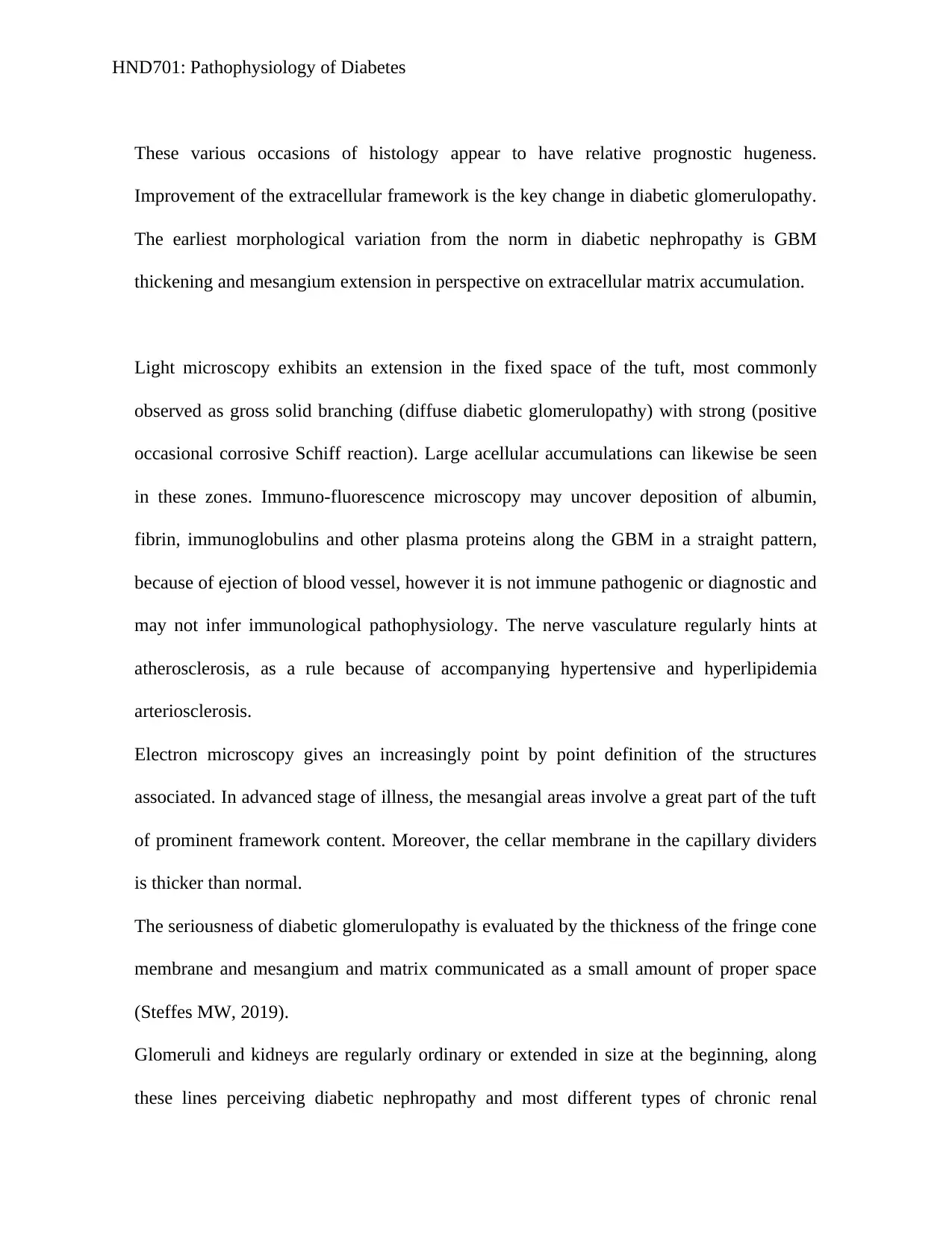
HND701: Pathophysiology of Diabetes
These various occasions of histology appear to have relative prognostic hugeness.
Improvement of the extracellular framework is the key change in diabetic glomerulopathy.
The earliest morphological variation from the norm in diabetic nephropathy is GBM
thickening and mesangium extension in perspective on extracellular matrix accumulation.
Light microscopy exhibits an extension in the fixed space of the tuft, most commonly
observed as gross solid branching (diffuse diabetic glomerulopathy) with strong (positive
occasional corrosive Schiff reaction). Large acellular accumulations can likewise be seen
in these zones. Immuno-fluorescence microscopy may uncover deposition of albumin,
fibrin, immunoglobulins and other plasma proteins along the GBM in a straight pattern,
because of ejection of blood vessel, however it is not immune pathogenic or diagnostic and
may not infer immunological pathophysiology. The nerve vasculature regularly hints at
atherosclerosis, as a rule because of accompanying hypertensive and hyperlipidemia
arteriosclerosis.
Electron microscopy gives an increasingly point by point definition of the structures
associated. In advanced stage of illness, the mesangial areas involve a great part of the tuft
of prominent framework content. Moreover, the cellar membrane in the capillary dividers
is thicker than normal.
The seriousness of diabetic glomerulopathy is evaluated by the thickness of the fringe cone
membrane and mesangium and matrix communicated as a small amount of proper space
(Steffes MW, 2019).
Glomeruli and kidneys are regularly ordinary or extended in size at the beginning, along
these lines perceiving diabetic nephropathy and most different types of chronic renal
These various occasions of histology appear to have relative prognostic hugeness.
Improvement of the extracellular framework is the key change in diabetic glomerulopathy.
The earliest morphological variation from the norm in diabetic nephropathy is GBM
thickening and mesangium extension in perspective on extracellular matrix accumulation.
Light microscopy exhibits an extension in the fixed space of the tuft, most commonly
observed as gross solid branching (diffuse diabetic glomerulopathy) with strong (positive
occasional corrosive Schiff reaction). Large acellular accumulations can likewise be seen
in these zones. Immuno-fluorescence microscopy may uncover deposition of albumin,
fibrin, immunoglobulins and other plasma proteins along the GBM in a straight pattern,
because of ejection of blood vessel, however it is not immune pathogenic or diagnostic and
may not infer immunological pathophysiology. The nerve vasculature regularly hints at
atherosclerosis, as a rule because of accompanying hypertensive and hyperlipidemia
arteriosclerosis.
Electron microscopy gives an increasingly point by point definition of the structures
associated. In advanced stage of illness, the mesangial areas involve a great part of the tuft
of prominent framework content. Moreover, the cellar membrane in the capillary dividers
is thicker than normal.
The seriousness of diabetic glomerulopathy is evaluated by the thickness of the fringe cone
membrane and mesangium and matrix communicated as a small amount of proper space
(Steffes MW, 2019).
Glomeruli and kidneys are regularly ordinary or extended in size at the beginning, along
these lines perceiving diabetic nephropathy and most different types of chronic renal
⊘ This is a preview!⊘
Do you want full access?
Subscribe today to unlock all pages.

Trusted by 1+ million students worldwide
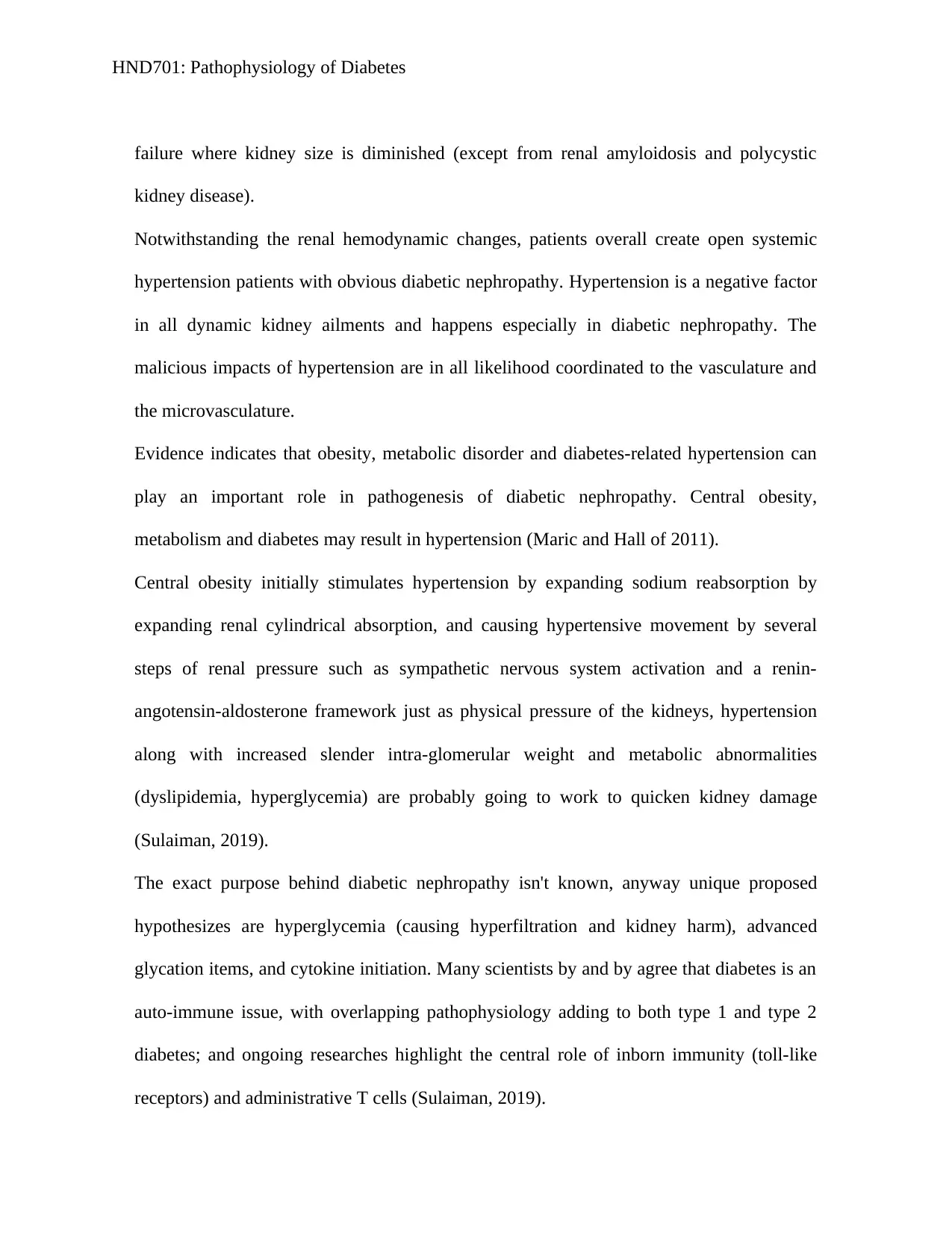
HND701: Pathophysiology of Diabetes
failure where kidney size is diminished (except from renal amyloidosis and polycystic
kidney disease).
Notwithstanding the renal hemodynamic changes, patients overall create open systemic
hypertension patients with obvious diabetic nephropathy. Hypertension is a negative factor
in all dynamic kidney ailments and happens especially in diabetic nephropathy. The
malicious impacts of hypertension are in all likelihood coordinated to the vasculature and
the microvasculature.
Evidence indicates that obesity, metabolic disorder and diabetes-related hypertension can
play an important role in pathogenesis of diabetic nephropathy. Central obesity,
metabolism and diabetes may result in hypertension (Maric and Hall of 2011).
Central obesity initially stimulates hypertension by expanding sodium reabsorption by
expanding renal cylindrical absorption, and causing hypertensive movement by several
steps of renal pressure such as sympathetic nervous system activation and a renin-
angotensin-aldosterone framework just as physical pressure of the kidneys, hypertension
along with increased slender intra-glomerular weight and metabolic abnormalities
(dyslipidemia, hyperglycemia) are probably going to work to quicken kidney damage
(Sulaiman, 2019).
The exact purpose behind diabetic nephropathy isn't known, anyway unique proposed
hypothesizes are hyperglycemia (causing hyperfiltration and kidney harm), advanced
glycation items, and cytokine initiation. Many scientists by and by agree that diabetes is an
auto-immune issue, with overlapping pathophysiology adding to both type 1 and type 2
diabetes; and ongoing researches highlight the central role of inborn immunity (toll-like
receptors) and administrative T cells (Sulaiman, 2019).
failure where kidney size is diminished (except from renal amyloidosis and polycystic
kidney disease).
Notwithstanding the renal hemodynamic changes, patients overall create open systemic
hypertension patients with obvious diabetic nephropathy. Hypertension is a negative factor
in all dynamic kidney ailments and happens especially in diabetic nephropathy. The
malicious impacts of hypertension are in all likelihood coordinated to the vasculature and
the microvasculature.
Evidence indicates that obesity, metabolic disorder and diabetes-related hypertension can
play an important role in pathogenesis of diabetic nephropathy. Central obesity,
metabolism and diabetes may result in hypertension (Maric and Hall of 2011).
Central obesity initially stimulates hypertension by expanding sodium reabsorption by
expanding renal cylindrical absorption, and causing hypertensive movement by several
steps of renal pressure such as sympathetic nervous system activation and a renin-
angotensin-aldosterone framework just as physical pressure of the kidneys, hypertension
along with increased slender intra-glomerular weight and metabolic abnormalities
(dyslipidemia, hyperglycemia) are probably going to work to quicken kidney damage
(Sulaiman, 2019).
The exact purpose behind diabetic nephropathy isn't known, anyway unique proposed
hypothesizes are hyperglycemia (causing hyperfiltration and kidney harm), advanced
glycation items, and cytokine initiation. Many scientists by and by agree that diabetes is an
auto-immune issue, with overlapping pathophysiology adding to both type 1 and type 2
diabetes; and ongoing researches highlight the central role of inborn immunity (toll-like
receptors) and administrative T cells (Sulaiman, 2019).
Paraphrase This Document
Need a fresh take? Get an instant paraphrase of this document with our AI Paraphraser
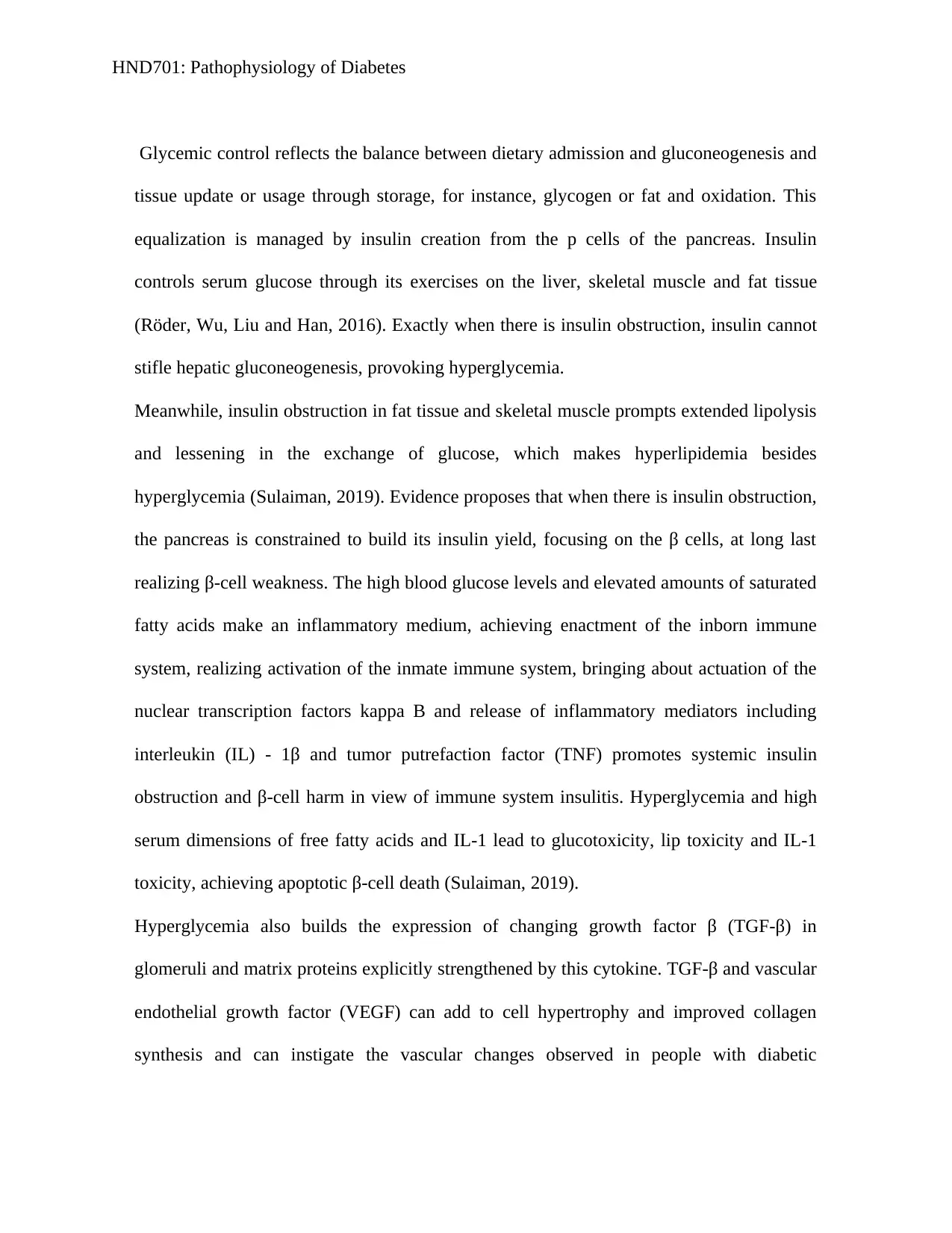
HND701: Pathophysiology of Diabetes
Glycemic control reflects the balance between dietary admission and gluconeogenesis and
tissue update or usage through storage, for instance, glycogen or fat and oxidation. This
equalization is managed by insulin creation from the p cells of the pancreas. Insulin
controls serum glucose through its exercises on the liver, skeletal muscle and fat tissue
(Röder, Wu, Liu and Han, 2016). Exactly when there is insulin obstruction, insulin cannot
stifle hepatic gluconeogenesis, provoking hyperglycemia.
Meanwhile, insulin obstruction in fat tissue and skeletal muscle prompts extended lipolysis
and lessening in the exchange of glucose, which makes hyperlipidemia besides
hyperglycemia (Sulaiman, 2019). Evidence proposes that when there is insulin obstruction,
the pancreas is constrained to build its insulin yield, focusing on the β cells, at long last
realizing β-cell weakness. The high blood glucose levels and elevated amounts of saturated
fatty acids make an inflammatory medium, achieving enactment of the inborn immune
system, realizing activation of the inmate immune system, bringing about actuation of the
nuclear transcription factors kappa B and release of inflammatory mediators including
interleukin (IL) - 1β and tumor putrefaction factor (TNF) promotes systemic insulin
obstruction and β-cell harm in view of immune system insulitis. Hyperglycemia and high
serum dimensions of free fatty acids and IL-1 lead to glucotoxicity, lip toxicity and IL-1
toxicity, achieving apoptotic β-cell death (Sulaiman, 2019).
Hyperglycemia also builds the expression of changing growth factor β (TGF-β) in
glomeruli and matrix proteins explicitly strengthened by this cytokine. TGF-β and vascular
endothelial growth factor (VEGF) can add to cell hypertrophy and improved collagen
synthesis and can instigate the vascular changes observed in people with diabetic
Glycemic control reflects the balance between dietary admission and gluconeogenesis and
tissue update or usage through storage, for instance, glycogen or fat and oxidation. This
equalization is managed by insulin creation from the p cells of the pancreas. Insulin
controls serum glucose through its exercises on the liver, skeletal muscle and fat tissue
(Röder, Wu, Liu and Han, 2016). Exactly when there is insulin obstruction, insulin cannot
stifle hepatic gluconeogenesis, provoking hyperglycemia.
Meanwhile, insulin obstruction in fat tissue and skeletal muscle prompts extended lipolysis
and lessening in the exchange of glucose, which makes hyperlipidemia besides
hyperglycemia (Sulaiman, 2019). Evidence proposes that when there is insulin obstruction,
the pancreas is constrained to build its insulin yield, focusing on the β cells, at long last
realizing β-cell weakness. The high blood glucose levels and elevated amounts of saturated
fatty acids make an inflammatory medium, achieving enactment of the inborn immune
system, realizing activation of the inmate immune system, bringing about actuation of the
nuclear transcription factors kappa B and release of inflammatory mediators including
interleukin (IL) - 1β and tumor putrefaction factor (TNF) promotes systemic insulin
obstruction and β-cell harm in view of immune system insulitis. Hyperglycemia and high
serum dimensions of free fatty acids and IL-1 lead to glucotoxicity, lip toxicity and IL-1
toxicity, achieving apoptotic β-cell death (Sulaiman, 2019).
Hyperglycemia also builds the expression of changing growth factor β (TGF-β) in
glomeruli and matrix proteins explicitly strengthened by this cytokine. TGF-β and vascular
endothelial growth factor (VEGF) can add to cell hypertrophy and improved collagen
synthesis and can instigate the vascular changes observed in people with diabetic
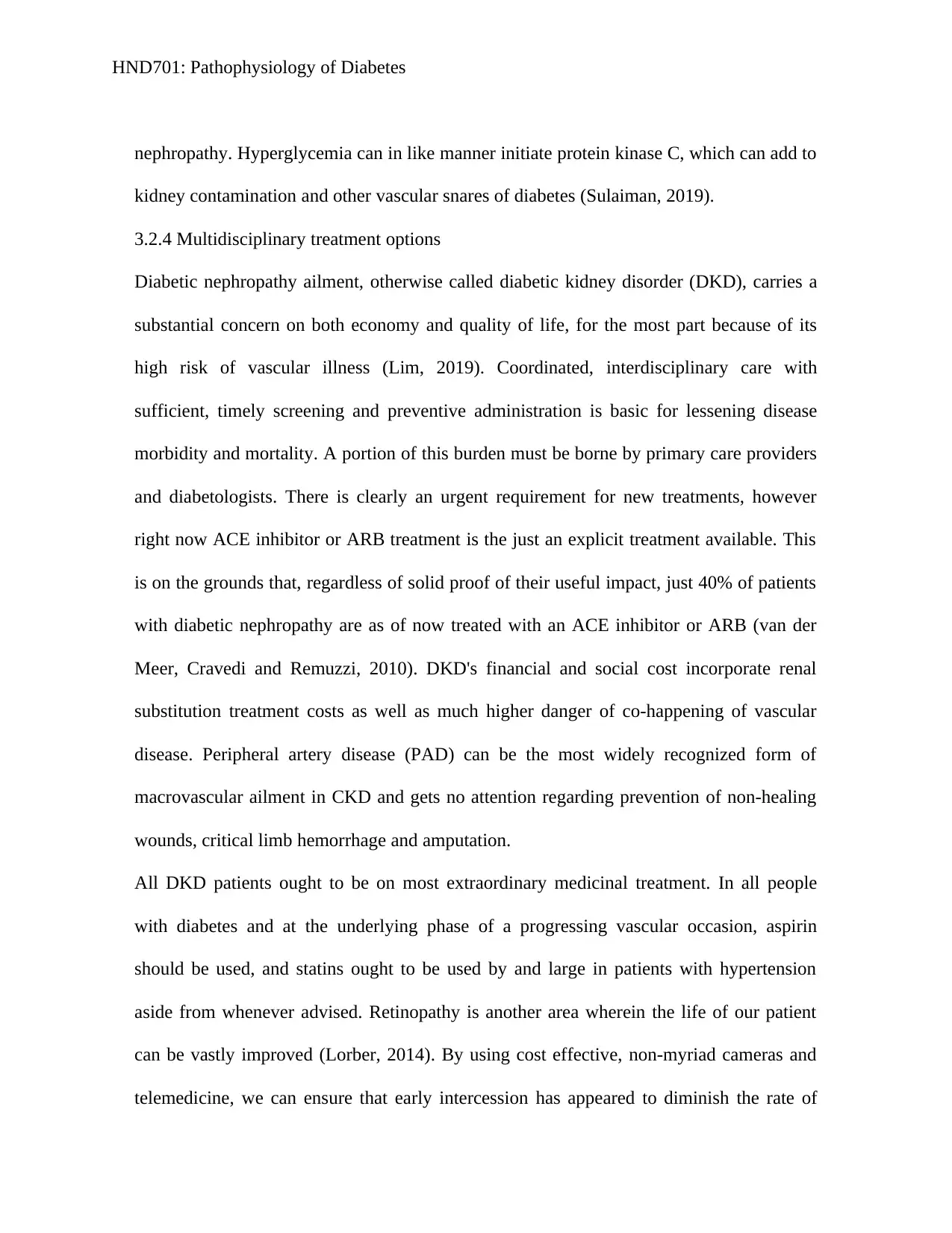
HND701: Pathophysiology of Diabetes
nephropathy. Hyperglycemia can in like manner initiate protein kinase C, which can add to
kidney contamination and other vascular snares of diabetes (Sulaiman, 2019).
3.2.4 Multidisciplinary treatment options
Diabetic nephropathy ailment, otherwise called diabetic kidney disorder (DKD), carries a
substantial concern on both economy and quality of life, for the most part because of its
high risk of vascular illness (Lim, 2019). Coordinated, interdisciplinary care with
sufficient, timely screening and preventive administration is basic for lessening disease
morbidity and mortality. A portion of this burden must be borne by primary care providers
and diabetologists. There is clearly an urgent requirement for new treatments, however
right now ACE inhibitor or ARB treatment is the just an explicit treatment available. This
is on the grounds that, regardless of solid proof of their useful impact, just 40% of patients
with diabetic nephropathy are as of now treated with an ACE inhibitor or ARB (van der
Meer, Cravedi and Remuzzi, 2010). DKD's financial and social cost incorporate renal
substitution treatment costs as well as much higher danger of co-happening of vascular
disease. Peripheral artery disease (PAD) can be the most widely recognized form of
macrovascular ailment in CKD and gets no attention regarding prevention of non-healing
wounds, critical limb hemorrhage and amputation.
All DKD patients ought to be on most extraordinary medicinal treatment. In all people
with diabetes and at the underlying phase of a progressing vascular occasion, aspirin
should be used, and statins ought to be used by and large in patients with hypertension
aside from whenever advised. Retinopathy is another area wherein the life of our patient
can be vastly improved (Lorber, 2014). By using cost effective, non-myriad cameras and
telemedicine, we can ensure that early intercession has appeared to diminish the rate of
nephropathy. Hyperglycemia can in like manner initiate protein kinase C, which can add to
kidney contamination and other vascular snares of diabetes (Sulaiman, 2019).
3.2.4 Multidisciplinary treatment options
Diabetic nephropathy ailment, otherwise called diabetic kidney disorder (DKD), carries a
substantial concern on both economy and quality of life, for the most part because of its
high risk of vascular illness (Lim, 2019). Coordinated, interdisciplinary care with
sufficient, timely screening and preventive administration is basic for lessening disease
morbidity and mortality. A portion of this burden must be borne by primary care providers
and diabetologists. There is clearly an urgent requirement for new treatments, however
right now ACE inhibitor or ARB treatment is the just an explicit treatment available. This
is on the grounds that, regardless of solid proof of their useful impact, just 40% of patients
with diabetic nephropathy are as of now treated with an ACE inhibitor or ARB (van der
Meer, Cravedi and Remuzzi, 2010). DKD's financial and social cost incorporate renal
substitution treatment costs as well as much higher danger of co-happening of vascular
disease. Peripheral artery disease (PAD) can be the most widely recognized form of
macrovascular ailment in CKD and gets no attention regarding prevention of non-healing
wounds, critical limb hemorrhage and amputation.
All DKD patients ought to be on most extraordinary medicinal treatment. In all people
with diabetes and at the underlying phase of a progressing vascular occasion, aspirin
should be used, and statins ought to be used by and large in patients with hypertension
aside from whenever advised. Retinopathy is another area wherein the life of our patient
can be vastly improved (Lorber, 2014). By using cost effective, non-myriad cameras and
telemedicine, we can ensure that early intercession has appeared to diminish the rate of
⊘ This is a preview!⊘
Do you want full access?
Subscribe today to unlock all pages.

Trusted by 1+ million students worldwide
1 out of 16
Related Documents
Your All-in-One AI-Powered Toolkit for Academic Success.
+13062052269
info@desklib.com
Available 24*7 on WhatsApp / Email
![[object Object]](/_next/static/media/star-bottom.7253800d.svg)
Unlock your academic potential
Copyright © 2020–2025 A2Z Services. All Rights Reserved. Developed and managed by ZUCOL.





